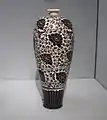Meiping
A meiping (Chinese: 梅瓶; pinyin: méipíng; lit. 'plum vase') is a type of vase in Chinese ceramics.[1] It is traditionally used to display branches of plum blossoms.[1][2] The meiping was first made of stoneware during the Tang dynasty (618–907).[3] It was originally used as a wine vessel, but since the Song dynasty (960–1279) it also became popular as a plum vase and got its name "meiping".[4] It is tall, with a narrow base spreading gracefully into a wide body, followed by a sharply-rounded shoulder, a short and narrow neck, and a small opening.[2][4][5]
They may have lids, and many lids have no doubt been lost. The equivalent shape in Korean ceramics, where it was derived from Chinese examples, is called a Maebyeong. A distinct variant is the "truncated meiping", where there is only the top half of the usual shape, giving a squat vase with a wide bottom. This is largely restricted to Cizhou ware.[6]
 Cizhou ware, 13th century, Song dynasty
Cizhou ware, 13th century, Song dynasty_with_Lotus_Sprays_LACMA_AC1999.38.6.1-.2.jpg.webp) Lidded vase with lotus sprays, Qingbai ware, Southern Song period
Lidded vase with lotus sprays, Qingbai ware, Southern Song period Yaozhou ware, celadon, Song dynasty
Yaozhou ware, celadon, Song dynasty_with_Horizontal_Ribs_LACMA_AC1994.191.1.jpg.webp) Vase with horizontal ribs, Southern Song period
Vase with horizontal ribs, Southern Song period_painted_in_copper-red_underglaze.JPG.webp) Vase with copper-red underglaze, Ming dynasty
Vase with copper-red underglaze, Ming dynasty 18th-century vase
18th-century vase Porcelain, Jingdezhen ware, painted with cobalt blue under transparent glaze, 15th century
Porcelain, Jingdezhen ware, painted with cobalt blue under transparent glaze, 15th century Meiping vase, Chinese, Ming Dynasty, 16th century CE. Arabic inscription. Porcelain with underglaze blue and small touches of overglaze enamel. Burrell Collection, Glasgow, UK
Meiping vase, Chinese, Ming Dynasty, 16th century CE. Arabic inscription. Porcelain with underglaze blue and small touches of overglaze enamel. Burrell Collection, Glasgow, UK
References
- Welch, Patricia Bjaaland (2008). Chinese art: a guide to motifs and visual imagery. North Clarendon: Tuttle Publishing. p. 17. ISBN 978-0-8048-3864-1.
- "Prunus Vase (meiping)". Saint Louis Art Museum. Retrieved 17 August 2011.
- "Fire Gilded Silver #Item3755". TK Asian Antiquities. Archived from the original on 31 March 2012. Retrieved 22 August 2011.
- "Meiping". Musée Guimet. Archived from the original on 30 September 2011. Retrieved 18 August 2011.
- "meiping". Encyclopædia Britannica. Retrieved 17 August 2011.
- Osborne, Harold (ed), The Oxford Companion to the Decorative Arts, p. 189, 1975, OUP, ISBN 0198661134
External links
- A Handbook of Chinese Ceramics from The Metropolitan Museum of Art
